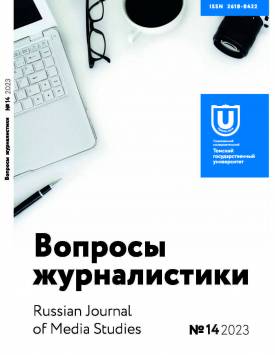Russian regional TV channels at the present stage: Traditional and Internet viewing of Siberian million-plus cities television
Regional TV channels cannot ignore the development of mobile and broadband Internet access in our country. In the case of regional TV channels, the situation has its own specifics: linear TV viewing of their content is now possible only in the version of cable TV or, if we talk about regional TV channels, several hours of regional inserts on the OTR channel. This study aims to identify the general patterns and features of the functioning on the Internet of TV channels producing content in the biggest Siberian cities and to characterize their audience, both in the variant of “classic” TV viewing and on various media platforms: websites, video hosting sites, and social media. To represent different segments of regional TV broadcasting, three types of channels were selected for analysis: regional (21 knopka), municipal, and commercial channels. The research methodology is based on a comparative method of analysis: the content and audience characteristics of TV channels are compared across different Internet platforms on which the channels are presented. The article also provides data from the research company MediaHills. Among the TV channels of the Siberian million-plus cities (Krasnoyarsk, Novosibirsk, and Omsk) created by local editorial offices, only three TV channels manage to overcome the audience of 150 thousand viewers. In Krasnoyarsk, it is a municipal channel, in Novosibirsk a private one, and in Omsk a regional one. The regional channels of Krasnoyarsk and Novosibirsk have audiences of 100 thousand people. The sites that gradually distance themselves from the archive-storage model for programs shown on TV have the largest number of views and enter the field of online news media, promoting the news agenda, usually with video support, but sometimes without it. As for video hosting, the Novosibirsk regional OTS has more than 100 thousand subscribers on YouTube. It also has the greatest number of subscribers on RuTube - almost five hundred people. This difference well shows the differences in the mastery of these two video hosting sites: although all the analyzed channels are presented on RuTube, their pages there are in their infancy. Four TV channels have from 50 to 100 thousand subscribers on YouTube, with Krasnoyarsk TV in the top. Almost all of the analyzed TV channels are represented on VKontakte, Odnoklassniki, and Telegram. The minority uses Zen. The most popular social network is VKontakte, in which not only the TV channels themselves, but also their individual programs have public pages. Despite the various “representations” of Siberian TV channels on the Internet, regional channels use most of the opportunities, while municipal and commercial channels seem to have no progressive online strategy, often limiting themselves to using the Internet to upload their programs. The author declares no conflicts of interests.
Keywords
Siberian TV channels, regional (21 knopka), municipal, commercial channels, websites, audience, video hosting, social mediaAuthors
| Name | Organization | |
| Belenko Victoria E. | Novosibirsk State University | viktoria_belenko@mail.ru |
References

Russian regional TV channels at the present stage: Traditional and Internet viewing of Siberian million-plus cities television | Voprosy zhurnalistiki – Russian Journal of Media Studies. 2023. № 14. DOI: 10.17223/26188422/14/1
